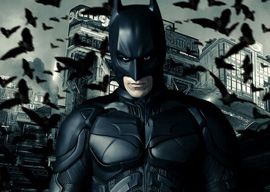
July 25, 2012

Nolan elicits deep allegiance from actors and crew, who keep returning to work with him in more movies where elaborate conspiracies serve as metaphors for filmmaking.
Unfortunately, Nolan’s latest Batman movie isn”t as seamless as 2010’s Inception. A studio executive should have made the call to push the blockbuster’s release back to Thanksgiving 2012 because the fit and polish aren”t up to Nolan’s usual standards. For instance, segues between scenes are often jarring, and the recorded dialogue sometimes lapses into incomprehensibility. Delivering giant movies every 24 months is hard even for Nolan.
Still, I admire his recurrent interest in the uncomfortable subject of being victimized by crime, which goes back to Following. After having his home broken into, Nolan decided to make a micro-budget movie about his question: What could the burglars be thinking?
Working weekends for a year, Nolan painstakingly shot Following on a budget of only $6,000, using friends from his college film club. Yet it still serves as a sort of allegory for his future career.
That may sound far-fetched, but Nolan is not a man who leaves much to chance. Perhaps it’s an accident that the main character in Following has a Batman symbol on his door, but it’s probably not a coincidence that he meets an ultra-competent thief called Cobb, a name Nolan revived for his mature masterpiece, Inception.
Following opens with a bedraggled young man named Bill, a lonely would-be writer on the dole, explaining to a skeptical Scotland Yard detective how he got into trouble. See, he started following random people around to come up with material for stories he was going to write.
One of the folks he shadowed turns out to be a charming, well-spoken, well-dressed upper-class burglar. Cobb breaks into people’s flats, but not for the money. Instead, he does it mostly to mess with his victims” psyches by, say, stealing only one earring from a pair. Cobb, who acts like Roger Moore in the James Bond movies, invites sad sack Bill to accompany him in a series of break-ins that are more performance art than larceny. But (spoiler alert!) it’s all a ruse to frame poor Bill with a woman’s murder.
Bizarrely, every commentary I”ve read on Following takes on faith the story Bill tells the policeman, even though the copper responds with numerous facts implying that Cobb, the dashing Old Etonian burglar, is an implausible figment of Bill’s imagination, a preposterous cover story improvised by Bill, who is less a crime novelist than a petty criminal-turned-sex murderer.
To critics, though, the preponderance of evidence against Bill only proves how diabolically clever Cobb must be. After all, seeing is believing, and we saw the unemployable loser talking to the toff, so it couldn”t all be in Bill’s head. I mean, would the director of Memento and The Prestige lie to us?
Moreover, where would we moviegoers be without our desire to believe in privileged murderers like Cobb? The reality of tedious, broken offenders like Bill is too dreary for us to even contemplate.